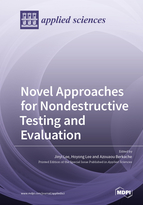Novel Approaches for Nondestructive Testing and Evaluation
A special issue of Applied Sciences (ISSN 2076-3417). This special issue belongs to the section "Mechanical Engineering".
Deadline for manuscript submissions: closed (10 August 2021) | Viewed by 32592
Special Issue Editors
Interests: corrosion; crack; nondestructive testing; NDT; magnetization; Hall sensor, GMR sensor; magnetic field; eddy current; magnetic camera; steel manufacturing; express train; nuclear power generation; heat exchanger; aerospace; NDE; ultrasonic non destructive
Special Issues, Collections and Topics in MDPI journals
Interests: failure analysis; magnetic sensors; nondestructive testing and evaluation; mechanical reliability of electronics system
Special Issues, Collections and Topics in MDPI journals
Interests: nondestructive testing; nondestructive evaluation; electromagnetic; numerical simulation
Special Issues, Collections and Topics in MDPI journals
Special Issue Information
Dear Colleagues,
Nondestructive testing and evaluation (NDT&E) is one of the most important techniques for determining the quality and safety of materials, components, devices, and structures. NDT&E technologies include ultrasonic testing (UT), magnetic particle testing (MT), magnetic flux leakage testing (MFLT), eddy current testing (ECT), radiation testing (RT), penetrant testing (PT), and visual testing (VT), and these are widely used throughout modern industry.
However, some NDT processes, such as cleaning specimens and removing paint, cause environmental pollution, and must be inspected in limited environments (time, space, and sensor selection). Thus, NDT&E is classified as a typical 3D (dirty, dangerous, and difficult) job. In addition, the NDT operator judges the presence of damage by experience and subjective judgment, so in some cases a flaw that exists may not be detected during the test. Therefore, to obtain clearer test results, a means for the operator to determine the flaw more easily should be provided. In addition, the test results should be organized systemically in order to identify the cause of the abnormality in the test specimen and to identify the progress of the damage quantitatively.
Due to the necessity of technical advancement in NDT&E, many efforts are being made in the following areas:
(1) Integration of test methods using conventional NDT&E methods.
(2) Ultra-precise sensor (sensitivity and resolution) development using advanced technology in electrical and electronic fields.
(3) Ultra-fast inspection (real-time NDT and high-speed flaw recognition).
(4) Automation of the inspection process (applying robot technology).
(5) Visualization of test results (2-D or 3-D visualization).
(6) Preservation and management of test results.
(7) Application of artificial intelligence.
Applied Sciences has planned a Special Issue, “Novel Approaches for Nondestructive Testing and Evaluation,” which has gathered the results of many researchers and engineers to meet the needs of technological advances in NDT&E.
We invite researchers and engineers with novel technologies for visualizing NDT signals such as those of visible, static/time-varying magnetic flux densities, radiation (infrared, ultraviolet, nuclear), electromagnetic waves, acoustics, and stresses using various physical and electrical and electronic methods. We also welcome related technologies such as those pertaining to the quantitative evaluation of test results. Case studies in all fields, including aerospace, electric power generation, petrochemicals, automobiles, and parts and materials, would also be valuable contributions to our Issue.
Papers published in Applied Sciences require the author or authors to bear the financial burden of open access, but the journal has a high Impact Factor (2.217). Moreover, we are confident that this Special Issue will provide a great opportunity to contribute to the future development of the NDT&E industry.
We look forward to your participation.
Prof. Dr. Jinyi Lee
Dr. Hoyong Lee
Dr. Azouaou Berkache
Guest Editors
Manuscript Submission Information
Manuscripts should be submitted online at www.mdpi.com by registering and logging in to this website. Once you are registered, click here to go to the submission form. Manuscripts can be submitted until the deadline. All submissions that pass pre-check are peer-reviewed. Accepted papers will be published continuously in the journal (as soon as accepted) and will be listed together on the special issue website. Research articles, review articles as well as short communications are invited. For planned papers, a title and short abstract (about 100 words) can be sent to the Editorial Office for announcement on this website.
Submitted manuscripts should not have been published previously, nor be under consideration for publication elsewhere (except conference proceedings papers). All manuscripts are thoroughly refereed through a single-blind peer-review process. A guide for authors and other relevant information for submission of manuscripts is available on the Instructions for Authors page. Applied Sciences is an international peer-reviewed open access semimonthly journal published by MDPI.
Please visit the Instructions for Authors page before submitting a manuscript. The Article Processing Charge (APC) for publication in this open access journal is 2400 CHF (Swiss Francs). Submitted papers should be well formatted and use good English. Authors may use MDPI's English editing service prior to publication or during author revisions.
Keywords
- nondestructive testing
- visible inspection
- infrared radiation
- X-ray and X-ray backscatter
- electromagnetic imaging
- phase array UT
- artificial intelligence
- evaluation
- reliability
- probability of detection








